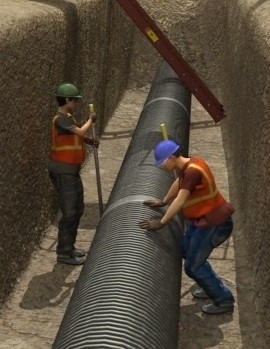Excavation Safety

Excavation is among the most hazardous of construction operations. An excavation is a man-made trench, cavity, depression or cut in the earth's surface formed by earth removal. An excavation can take place in someone's backyard or cellar or during highway construction. Excavation workers must comply with OSHA standards before and during an excavation job to prevent injuries and fatalities.
OSHA History
Congress created the Occupational Health and Safety Administration in 1970 under the Occupational Health and Safety Act to prevent work-related illnesses, injuries and deaths. Employers and employees must follow the regulations outlined in the act. Since OSHA was created, injuries have declined by 42 percent and deaths have been cut by 62 percent. The OSHA act outlines excavation safety and the methods employers must follow to prevent hazardous health accidents and injuries in the work environment.
Health Warnings
Employees who perform excavation work must be warned of the serious health and safety dangers involved with excavation. Hazards involved with excavation work include falling loads, falls, incidents involving mobile equipment and hazardous atmospheres. Cave-in accidents pose a great risk to excavation workers and are more likely to cause worker fatalities than any other excavation-related accident.
Standard Regulations
OSHA has standard excavation regulations that must be followed by excavation workers and employers. All surface encumbrances that are located so as to create a hazard to employees must be removed or supported to help safeguard employees. Prior to opening an excavation, the presence of sewers, water and fuel lines, electric and telephone lines and other underground installations must be determined. Employees exposed to public vehicular traffic must wear warning vests and other reflective or highly visible garments; employers are required to provide these.
Exclusions
Certain excavation work does not have to follow OSHA excavation standards. Exclusions include basement or house foundation excavations less than seven and a half feet deep, with a bottom framework at least two feet wide. No heavy equipment can be operating that would vibrate the excavation while an employee is in it, there must be as few crew members working in the excavation as possible, and the time spent in the excavation must be kept to a minimum.
Considerations
To maintain excavation safety, excavation workers and employers should research specifics about the job before bidding on it. Employers should know as much about the job-site conditions as possible, such as the traffic, surface and ground water, soil, location of water table, weather, overhead and underground utilities, physical conditions, proximity of nearby structures and all other information needed to ensure that the necessary safety equipment in compliance with OSHA standards is on site.
OSHA History
Congress created the Occupational Health and Safety Administration in 1970 under the Occupational Health and Safety Act to prevent work-related illnesses, injuries and deaths. Employers and employees must follow the regulations outlined in the act. Since OSHA was created, injuries have declined by 42 percent and deaths have been cut by 62 percent. The OSHA act outlines excavation safety and the methods employers must follow to prevent hazardous health accidents and injuries in the work environment.
Health Warnings
Employees who perform excavation work must be warned of the serious health and safety dangers involved with excavation. Hazards involved with excavation work include falling loads, falls, incidents involving mobile equipment and hazardous atmospheres. Cave-in accidents pose a great risk to excavation workers and are more likely to cause worker fatalities than any other excavation-related accident.
Standard Regulations
OSHA has standard excavation regulations that must be followed by excavation workers and employers. All surface encumbrances that are located so as to create a hazard to employees must be removed or supported to help safeguard employees. Prior to opening an excavation, the presence of sewers, water and fuel lines, electric and telephone lines and other underground installations must be determined. Employees exposed to public vehicular traffic must wear warning vests and other reflective or highly visible garments; employers are required to provide these.
Exclusions
Certain excavation work does not have to follow OSHA excavation standards. Exclusions include basement or house foundation excavations less than seven and a half feet deep, with a bottom framework at least two feet wide. No heavy equipment can be operating that would vibrate the excavation while an employee is in it, there must be as few crew members working in the excavation as possible, and the time spent in the excavation must be kept to a minimum.
Considerations
To maintain excavation safety, excavation workers and employers should research specifics about the job before bidding on it. Employers should know as much about the job-site conditions as possible, such as the traffic, surface and ground water, soil, location of water table, weather, overhead and underground utilities, physical conditions, proximity of nearby structures and all other information needed to ensure that the necessary safety equipment in compliance with OSHA standards is on site.
- 0a5eb1b9fbe9bbd50c859a92794814f75c.jpg
- f462d9a95caa414cebb2e94ec9b1fc716e.jpg